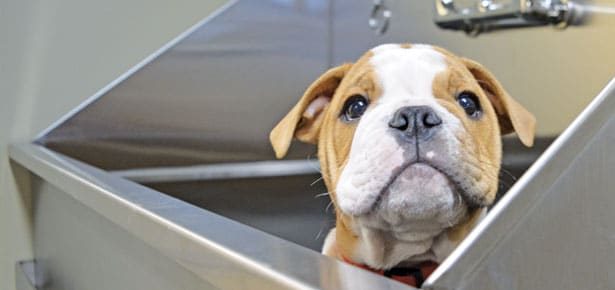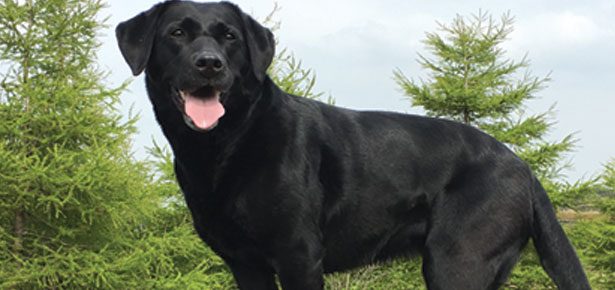

The Man with 1200 Dogs
An animal sanctuary in Thailand offers second chances for stray, abandoned, and injured dogs.
“I’m kind of an extreme guy,” Michael J. Baines says. “I have over 200 tattoos. I have 1,200 dogs.”
Baines is the president and co-founder of The Man That Rescues Dogs (TMTRD) in Bang Phra, Thailand, just outside of Bangkok. Baines and his staff care for 800 dogs in the sanctuary, along with an additional 400 street dogs that his team have had spayed or neutered and now feed and monitor daily.
He relies on the generosity of animal lovers to pay for everything. “I get donations from all over the world,” he says. “The total cost per day is $1,600 US to keep my foundation up and running.”
Baines never planned to devote his life to dogs. Born in Scotland and raised in Sweden, he studied dance and theatre—briefly enjoying the spotlight as a breakdancer with the stage name Sugar Rock—before enrolling in culinary school in Sweden and working in kitchens around Stockholm. The restaurant industry’s long hours and party atmosphere led him to become addicted to drugs and alcohol, transforming him into a person he scarcely recognizes now. “The farther into the substances I went, the further away from compassion I drifted,” he writes in his 2024 memoir, Home. Made.
When a coworker who frequently vacationed in Thailand—and always returned with renewed energy and a healthy glow—invited him to tag along, Baines went. “Thailand was a mini cleanse, an utter relief for my body,” he shares in his memoir. “I returned to Stockholm and my substance-heavy lifestyle, but I had tasted a bit of freedom, and I started craving that feeling just as much as I had craved the drugs.”
Baines began visiting Thailand as often as possible, and within a few years, he landed a job there as a restaurant manager. Upon moving to the country in 2002, he immediately stopped doing drugs, but ending his decade-long addiction to alcohol proved more of a struggle. “It was years until I didn’t feel tempted,” he writes. “I feigned dependability until it became a habit. Work became an amazing foundation on which to build structure.”
His animal rescue work in Thailand started with a single dog. “There was a dog that showed up behind my restaurant and was in really bad shape. I fed her every day for five days, and I gained her trust. I picked her up, I put her in my truck, and I drove to the veterinarian,” he says. Thanks to his intervention, this sickly, malnourished animal transformed into a healthy dog, and Baines managed to find a loving home for her. “Seeing her like this and knowing that I had facilitated this filled me with satisfaction, connectedness, and optimism—feelings I didn’t know I had access to. I fulfilled my promise to her, and knowing I was capable of changing her story, developed my awareness that there were other fates I could rewrite,” he writes in his memoir. “Mamuang was my first rescue. And this feeling would prove to be more euphoric than drugs, alcohol, or love.”
He sold his business in 2018 and devoted his life to the dogs: “I decided to cook for dogs instead of people.”
Baines began to notice all of the other dogs in the area that were also skinny, hungry, and suffering. He started feeding them—more and more of them each day—while also running the small restaurant that he had opened in 2013. “That was my plan: feeding 80 to 100 dogs per day and continuing my restaurant,” he says. But then a whistleblower contacted him about the horrific state of the local dog pound, and Baines felt compelled to check it out. Shocked by what he saw, he soon took it over. For a while, he ran both the dog pound and his restaurant, but eventually, it became too much. A choice was inevitable. He sold his business in 2018 and devoted his life to the dogs: “I decided to cook for dogs instead of people.”
After multiple expansions over the years, his 8,000-square-metre shelter now houses 800 dogs. They all require food, exercise, grooming, and veterinary care. Baines employs a staff of 45—including two veterinarians—and also enlists the help of volunteers and veterinary interns from abroad. He says, “It’s good for us. It’s good for them. It’s good for the dogs.”
Meet the Wheelchair Mafia
One specific group of pooches at TMTRD has received much attention on social media: the Wheelchair Mafia. “We have about 44 dogs in wheelchairs, rescued since 2016, and they’re a bunch of happy yappers,” Baines says. “They don’t know they’re paralyzed.” And they don’t waste time feeling sorry for themselves. “They still live their life.”
“We have about 44 dogs in wheelchairs…They don’t know they’re paralyzed.” And they don’t waste time feeling sorry for themselves. “They still live their life.”
These disabled dogs are delighted to set out on their walks each day at 6 a.m. and 1:45 p.m., which are possible thanks to sturdy wheelchairs designed by an American company called Walkin’ Pets. Though the devices are pricey, they give the animals tremendous freedom. “I want the best quality for our dogs,” Baines says. “They can run over ditches and stones. They can even swim with them.”
Online videos of the Wheelchair Mafia getting ready to embark on a walk capture the sheer joy of the experience. “The excitement that hangs in the air is palpable as the dogs are strapped into their chairs the same way a pit crew prepares a race car driver for action. They line up one by one and take their places at the starting line,” Baines writes in his memoir. “The scene is surreal. It feels like an F1 start as they all want to take the lead. But, after a minute, they find their rhythm and coordinate themselves into formation beside staff members, volunteers, and visitors… Their happiness never falters, and they are not shy to express their gratitude. There is nothing like the howls of 44 dogs celebrating their limitlessness.”
Baines invites anyone who has felt moved by the Wheelchair Mafia videos on TikTok, Instagram, Facebook, or YouTube to visit the sanctuary and see the mutts in motion in real life. “You get more awareness that the dog is not done with life just because they’re paralyzed or have amputated legs,” he says. Of the dogs that live with Baines personally, three have had a leg amputated. When people express sadness for these three-legged animals—which happens a lot—Baines always replies: “Hey, you only have two legs.”
He becomes especially passionate when talking about the importance of spaying and neutering to help control the stray population. The TMTRD veterinary clinic offers these services, along with vaccinations and dental cleanings, on a cost-recovery basis, to encourage locals to take proper care of their pets. Those who neglect to do so “hand over the problem to us,” Baines says. TMTRD has spayed or neutered each of the 400 street dogs on the daily feeding route and provides veterinary care whenever needed.
When discussing why he doesn’t house these 400 strays in the shelter, Baines is matter of fact about the situation. “First of all, we don’t have enough space,” he says. “Second is that most of these dogs live in an area where they are safe. It’s their home. We can’t forget that.” It takes a staff member about six hours each day to drive around to check on and feed the animals. “It’s my original route,” Baines says. And some of the dogs he fed all those years ago are still alive today. “Amazingly.”
Baines has lived with as many as 18 dogs in his personal residence, and he currently shares his home with 15, but he vows he won’t take in more. “I say every time a dog passes away, that’s it, no more dogs,” he says, laughing. “Ask me again in one year. I suck at saying no. I love them all.”
“There are so many dogs sitting and waiting in shelters all over the world for their hero.” He notes that more than one million shelter dogs are euthanized in the United States each year. “That’s why we urge people to adopt locally.”
Though Baines would like nothing more than to find loving homes for all the dogs housed at TMTRD, he’s extremely careful about approving adoptions. “People are interested, but we don’t approve them all,” he says. “If the dogs have a worse life than here with us, I will not rehome them.” And he refuses to send dogs abroad. “There are so many dogs sitting and waiting in shelters all over the world for their hero.” He notes that more than one million shelter dogs are euthanized in the United States each year. “That’s why we urge people to adopt locally.”
As for finding the money to pay for everything that TMTRD does, Baines must get creative. “Some months are bad. Some months are better,” he says. Donations dropped precipitously during the COVID-19 pandemic but picked up again after a video of the dogs went viral. Popular video clips of the Wheelchair Mafia always boost donations, as do features on pet websites. Baines hopes a sequel to the 2013 documentary The Man That Rescues Dogs, which was produced by Swedish filmmaker Anna Tjernström and can be viewed on YouTube, might still come to fruition.
The memoir that Baines wrote recently, Home. Made., is the first book published by Witchcraft Creative, a social enterprise with the goal of helping nonprofit organizations raise funds while telling their own stories. When Witchcraft founder Samantha Wilson reached out to Baines to encourage him to write about his amazing life and work, he only agreed because 70 percent of the royalties go back to his foundation. “It was an emotional rollercoaster,” he says of the writing experience. “I had to dig very deep.”
He plans to expand the sanctuary by another 2,000 square metres, then simply maintain it. “I’m not going to expand more. I’m not going to open up branches. I’m not going to go to other countries and do this. We have enough dogs in our area that need our attention, and I’m not going to jeopardize the dogs and staff we have,” he says. “I just need to make sure that the dogs are safe and the staff and the foundation can move forward for many years to come.”
The hours may be long, but the work is rewarding. “It’s my baby. It’s my foundation, and I need to take care of it,” he says. “It’s work, but it’s not a job.”
The man who has been a breakdancer, a chef, an addict, and an author before finding his calling as The Man That Rescues Dogs believes in the power of new beginnings, especially for those who have been misunderstood and abandoned. In his memoir, he writes about a scared but sweet pit bull rescue named Blueberry: “He wasn’t a menace. He was misunderstood and mistreated. I recognize now this common theme that unites the misfits of The Man That Rescues Dogs—both animal and human.”
Several of the staff who work at TMTRD have histories as checkered as Baines’ own past, which makes them apt caretakers for dogs that have been ignored or discarded by society. “I think it’s about second chances,” Baines says. “We give them a second chance. Life has given me a second chance.”
“But the dogs are so innocent, and they’re lovely creatures. I love to bond with them. They’re honest. They live day by day.”
As Baines ponders why dogs have become the singular focus of his life, he becomes thoughtful, recalling the many twists and turns of his personal life story. “When you’re at a crossroad, you choose the path. I could have chosen not to take the first dog in. I could have chosen not to close my restaurant,” he says. “But the dogs are so innocent, and they’re lovely creatures. I love to bond with them. They’re honest. They live day by day.” He says frankly, “I cannot stop now. How could I?”
*Visit tmtrd.org to learn more about donating to The Man That Rescues Dogs or volunteering at the sanctuary. See videos of the Wheelchair Mafia and the other rescued dogs by following @tmtrdorg on Instagram.
This article originally appeared in the award-winning Modern Dog magazine. Subscribe today!
Join the newsletter and never miss out on dog content again!
"*" indicates required fields
By clicking the arrow, you agree to our web Terms of Use and Privacy & Cookie Policy. Easy unsubscribe links are provided in every email.








